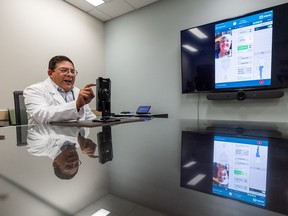A specialist in remote care robotics and a Saskatchewan post-education leader see solutions for the health-care gap for Indigenous people.

The Canadian Chart of Rights and Freedoms, at its core, enshrines the equality of rights for all Canadians. However, there is an enduring inequity for Indigenous people accessing health care compared to non-Indigenous populations.
According to Statistics Canada, the life expectancy for an Indigenous male is eight years shorter, and for an Indigenous female 6.9 years shorter, than their non-Indigenous counterparts. The prevalence of diabetes in people living on reserves is three times that of non-Indigenous populations.
Advertisement 2
THIS CONTENT IS RESERVED FOR SUBSCRIBERS ONLY
Subscribe now to read the latest news in your city and across Canada.
- Unlimited online access to articles from across Canada with one account.
- Get exclusive access to the Saskatoon StarPhoenix ePaper, an electronic replica of the print edition that you can share, download and comment on.
- Enjoy insights and behind-the-scenes analysis from our award-winning journalists.
- Support local journalists and the next generation of journalists.
- Daily puzzles including the New York Times Crossword.
SUBSCRIBE TO UNLOCK MORE ARTICLES
Subscribe now to read the latest news in your city and across Canada.
- Unlimited online access to articles from across Canada with one account.
- Get exclusive access to the Saskatoon StarPhoenix ePaper, an electronic replica of the print edition that you can share, download and comment on.
- Enjoy insights and behind-the-scenes analysis from our award-winning journalists.
- Support local journalists and the next generation of journalists.
- Daily puzzles including the New York Times Crossword.
REGISTER TO UNLOCK MORE ARTICLES
Create an account or sign in to continue with your reading experience.
- Access articles from across Canada with one account.
- Share your thoughts and join the conversation in the comments.
- Enjoy additional articles per month.
- Get email updates from your favourite authors.
Article content
Article content
Active tuberculosis rates among the Inuit are three times higher than among non-Indigenous people, and infant mortality in Nunavut is four times higher than the national average. The suicide rate of young First Nations males living on reserves is seven times higher than for non-Indigenous youth.
These disheartening statistics show a huge gap in health-care delivery to Indigenous Canadian populations.
A significant barrier in health-care delivery is the remote geographical locations of many Indigenous communities. The costs of transporting Indigenous patients for health care is enormous; the First Nations and Inuit Health Branch expends more in medical transportation than in any other health-care service.
Last year, a report showed a 14.5 per cent increase in transportation costs compared to the previous year, reaching a whopping $602 million nationally; of that, $103.5 million was spent in Saskatchewan transporting Indigenous patients.
Access to virtual care technologies will help address this geographical barrier and provide timely, clinically effective, and cost-efficient health care to these communities.
By signing up you consent to receive the above newsletter from Postmedia Network Inc.
Article content
Advertisement 3
Article content
Substantial developments in mobile computing technology and the increasing accessibility to high-speed Internet services provided by low-earth-orbit satellites can help to narrow the digital divide to these populations.
For the past several years, we have been co-developing, with Indigenous communities, culturally appropriate, innovative virtual care solutions aimed at the most vulnerable segments such as children and pregnant women.
We have shown that with this technology, about 70 per cent of acutely ill children in remote locations can be treated in their own communities.
We have implemented tele-robotic sonography to provide prenatal ultrasound services to pregnant Indigenous women and it has proved to be clinically effective, with a high degree of acceptance and satisfaction by clinicians and patients. It was also culturally safe and cost efficient.
We envision a virtual health hub that will be able to scale up multiple health services to Indigenous communities across Saskatchewan and beyond.
We are in a pivotal time in the evolution of technology with the massive and brisk influx of artificial intelligence (AI) in our lives, advances in 5G connectivity, robotic technology and the surge of virtual health care during the pandemic.
Advertisement 4
Article content
These technological developments are unstoppable and will be transformative to health-care delivery. There is an urgent need to retool our health-care workforce by incorporating these changes into current training paradigms.
A core strategic goal of the Saskatchewan Indian Institute of Technologies (SIIT) is to advance an innovation agenda for our learners.
We aim to be leaders in training the virtual health-care workers of the future. Incorporating state-of-the-art virtual care technologies such as AI into our health-care programs is a priority for SIIT.
This new generation of Indigenous health-care workers is vital to improve health care for Indigenous communities in Saskatchewan and the rest of Canada.
The future of Indigenous health is in empowering communities and Indigenous professionals to harness the full potential of technology to provide effective and culturally relevant health care to our Indigenous population, which is the youngest in Canada and growing at twice the pace of the general population.
Ivar Mendez is the director of the Virtual Care and Remote Presence Robotics Program at the University of Saskatchewan and the Virtual Health Hub. Riel Bellegarde is president and CEO of the Saskatchewan Indian Institute of Technologies.
Advertisement 5
Article content
Related Stories
Share your views
With some online platforms blocking access to the journalism upon which you depend, our websites are your destination for up-to-the-minute news, so make sure to bookmark TheStarPhoenix.com and LeaderPost.com. For Regina Leader-Post newsletters click here; for Saskatoon StarPhoenix newsletters click here.
Article content



